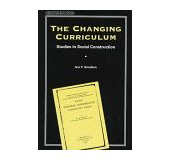The Changing Curriculum: studies in social construction
Chariots of Fire
Antecedents and Alternatives
The epistemology and institutionalised system of State schooling briefly described above was in sharp contrast to antecedent forms of education and to the involvement of the State in schooling at this earlier stage. Rothblatt for instance describes education in Georgian England as follows:
The State was not interested in 'national education' - indeed the idea had not yet occurred. The Church, which was interested in education, because of its continuing rivalry with Dissent, still did not have a firm policy and left the direction of studies to local or personal initiatives, or to the forces of the market. The demand for education and the demand for particular levels of education varied radically from period to period and from group to group, depending upon social and economic circumstances, occupational distributions, and cultural values. Countless persons, lay as well as clerical, opened schools, tried out various educational experiments and programmes in an effort to retain a fickle or uncertain clientele. And home tuition, where adjustments in curricula could be made quickly and easily according to the learning ability of the pupil, certainly remained one of the most important means of elementary and secondary education throughout the nineteenth century (Rothblatt 1976, p. 45).
Such a personal and local mode of educating could well have allowed response to the experience and culture of the pupils even in situations less ideal than home tuition 'where adjustments could be made quickly and easily according to the learning ability of pupil'. But among working class groups certainly in the sphere of adult education such respect for life experience in curriculum was a feature at this time and later. This contribution can be summarised as: 'the students' choice of subject. The relation of disciplines to actual contemporary living and the parity of general discussion with expert instruction' (Williams 1975, p. 165). Above all there is the idea of curriculum as a two-way conversation rather than a one-way transmission.
Likewise different patterns of education and attendance characterised the working class private school, which thrived in the first half of the nineteenth century and continued into the second half in many places even after the 1870 act. Harrison has described these schools and the views that State inspectors held of them:
Government inspection and middle class reformers condemned such schools as mere baby-minding establishments. They noted with strong disapproval the absence of settled or regular attendance. The pupils came and went at all times during the day. School hours were nominal and adjusted to family needs - hence the number of two- and three- year olds who were sent to be 'out of the way' or 'kept safe'. The accommodation was over-crowded and sometimes stuffy, dirty and unsanitary. The pupils were not divided into classes, and the teacher was a working man or woman...
